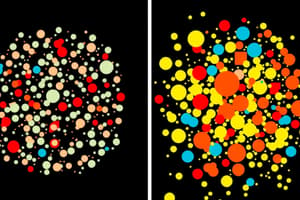Podcast
Questions and Answers
What is the primary goal of the first step in data classification?
What is the primary goal of the first step in data classification?
- To categorize future data samples
- To identify the class labels of the training samples
- To build a model that describes a predetermined set of data classes or concepts (correct)
- To estimate the predictive accuracy of the model
What is the term used to describe the learning process when the class labels of the training samples are not known?
What is the term used to describe the learning process when the class labels of the training samples are not known?
- Reinforcement learning
- Unsupervised learning (correct)
- Semi-supervised learning
- Supervised learning
What is the purpose of the holdout method in data classification?
What is the purpose of the holdout method in data classification?
- To identify the class labels of the training samples
- To categorize future data samples
- To estimate the predictive accuracy of the model (correct)
- To build a model that describes a predetermined set of data classes or concepts
What is the term used to describe the individual tuples making up the training set?
What is the term used to describe the individual tuples making up the training set?
What is the result of the learning process in the first step of data classification?
What is the result of the learning process in the first step of data classification?
What is the purpose of the second step in data classification?
What is the purpose of the second step in data classification?
What is the definition of supervised learning in the context of data classification?
What is the definition of supervised learning in the context of data classification?
What is the term used to describe the data tuples analyzed to build the model?
What is the term used to describe the data tuples analyzed to build the model?
What is the purpose of using a test set in classification?
What is the purpose of using a test set in classification?
What is the target variable in a classification task?
What is the target variable in a classification task?
What is the main goal of classification in data mining?
What is the main goal of classification in data mining?
What is the purpose of analyzing the training data in classification?
What is the purpose of analyzing the training data in classification?
What is the term for when a model performs well on the training data but poorly on new data?
What is the term for when a model performs well on the training data but poorly on new data?
What is the purpose of classification rules in classification?
What is the purpose of classification rules in classification?
What is an example of a popular classification technique?
What is an example of a popular classification technique?
What is the term for predicting a numerical value?
What is the term for predicting a numerical value?
Flashcards are hidden until you start studying
Study Notes
Data Classification
- Data classification is a two-step process: building a model and using the model for classification.
- The model is constructed by analyzing database tuples (samples, examples, or objects) described by attributes.
- Each tuple is assumed to belong to a predefined class, as determined by the class label attribute.
Supervised Learning
- In the first step, the model is built using a supervised learning approach, where the class label of each training sample is provided.
- The learning process is 'supervised' in that it is told to which class each training sample belongs.
- The learned model is typically represented in the form of classification rules, decision trees, or mathematical formulae.
Classification Rules
- Classification rules can be used to categorize future data samples and provide a better understanding of the database contents.
- Example: given a database of customer credit information, classification rules can be learned to identify customers as having either excellent or fair credit ratings.
Model Evaluation
- The predictive accuracy of the model is estimated using a test set of class-labeled samples.
- The holdout method is a simple technique that uses a test set of class-labeled samples to evaluate the model's accuracy.
- The accuracy of a model on a given test set is the percentage of test set samples that are correctly classified by the model.
Avoiding Overfitting
- If the accuracy of the model were estimated based on the training data set, this estimate could be optimistic since the learned model tends to overfit the data.
- Therefore, a test set is used to evaluate the model's accuracy to avoid overfitting.
Classification
- Classification is a data mining technique used to predict group membership for data instances.
- It is used to predict categorical variables, such as income bracket, which can be partitioned into multiple classes or categories.
- Popular classification techniques include decision trees and neural networks.
Classification Task
- A classification task involves examining a large set of records, each containing information on the target variable and a set of input or predictor variables.
- The goal is to classify the target variable (e.g., income brackets) based on the input variables (e.g., age, gender, and occupation).
Studying That Suits You
Use AI to generate personalized quizzes and flashcards to suit your learning preferences.




